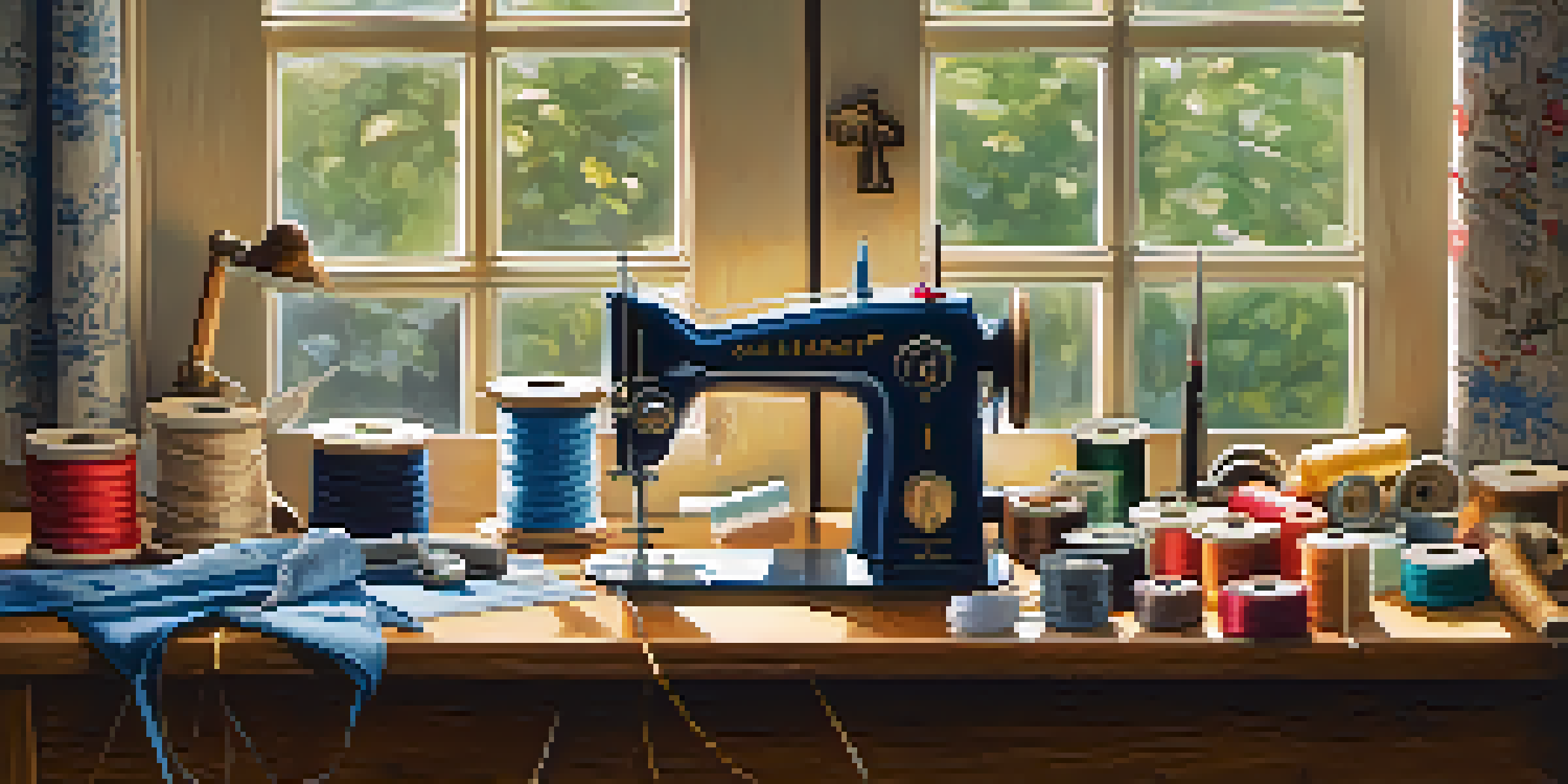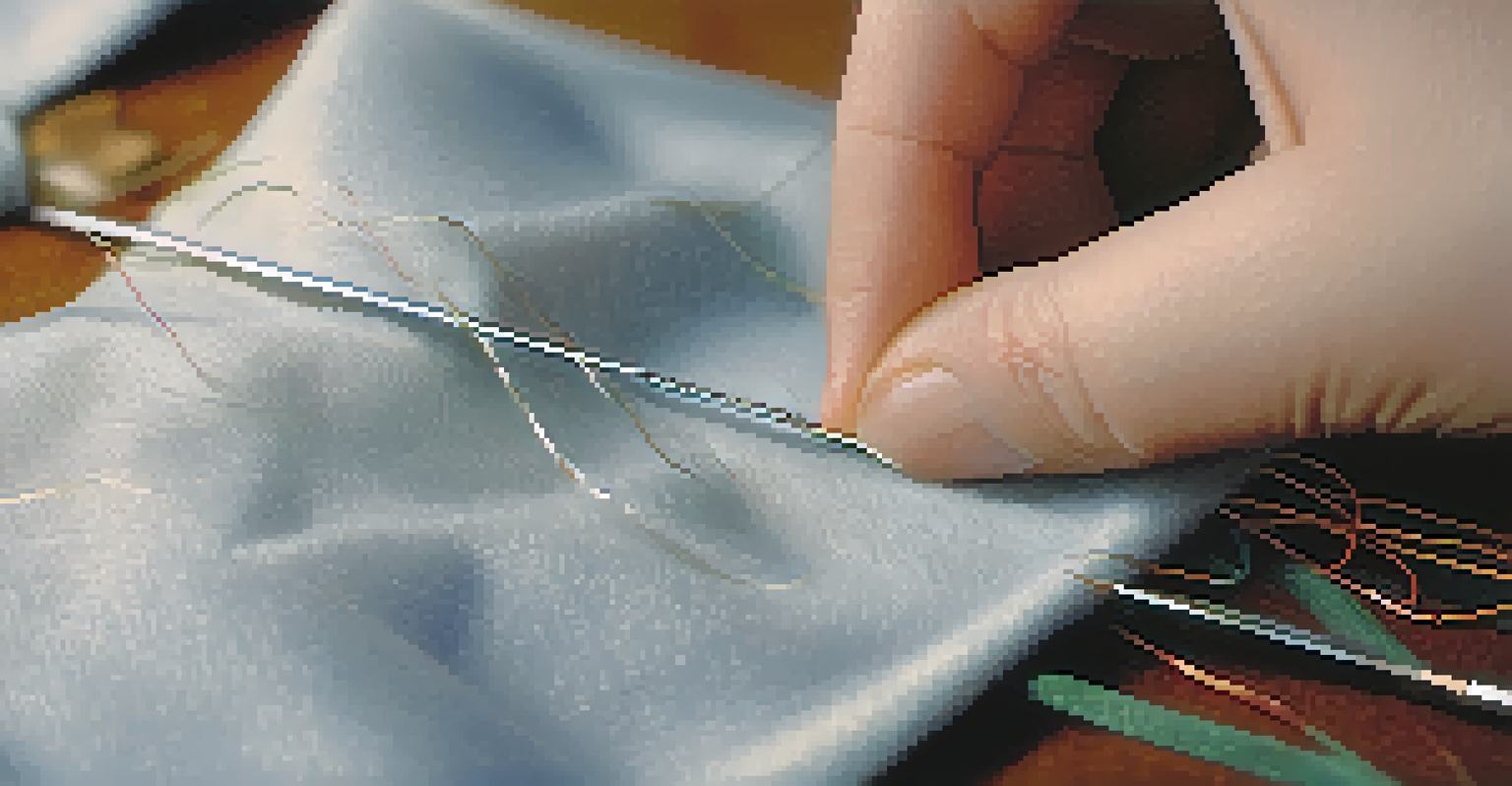Essential Sewing Techniques Every Beginner Should Master

Understanding Basic Sewing Tools for Beginners
Before diving into sewing, it's crucial to familiarize yourself with the basic tools. Essential items include scissors, pins, needles, and a measuring tape. Each tool plays a distinct role, making your sewing experience smoother and more enjoyable.
Sewing is not just a hobby; it's a way to express yourself and create something unique.
For instance, fabric scissors are designed specifically for cutting fabric, ensuring clean edges. In contrast, regular scissors can dull quickly and ruin your fabric. Investing in a good set of tools not only enhances your sewing quality but also builds your confidence as a beginner.
Additionally, having a sewing machine can significantly speed up your projects. While hand sewing is valuable, a machine opens up a world of possibilities, allowing you to explore different techniques and patterns with ease.
Mastering Straight and Curved Sewing Stitches
Stitching is the foundation of sewing, and mastering straight and curved stitches is essential. A straight stitch is often the go-to for seams, while a curved stitch comes in handy for hems and rounded edges. Practicing these stitches will help you feel more comfortable with your sewing machine or hand sewing.

To practice, try sewing straight lines on scrap fabric, gradually increasing your speed. Once you feel confident, move on to curves. Remember, slow and steady wins the race; precision is more important than speed!
Essential Tools for Beginners
Familiarizing yourself with basic sewing tools like scissors, pins, and a sewing machine enhances your sewing experience and builds confidence.
As you become more proficient, you can experiment with decorative stitches. These added details can elevate your projects, giving them a professional touch while showcasing your creativity.
Learning to Read and Use Sewing Patterns
Sewing patterns are like roadmaps for your projects, guiding you through the construction process. Understanding how to read these patterns is crucial for success. They include important information such as fabric requirements, cutting layouts, and step-by-step instructions.
The only way to improve your sewing skills is to practice, practice, practice.
Start with simple patterns that match your skill level to avoid feeling overwhelmed. As you become comfortable, you can gradually tackle more complex designs. Remember, taking your time to understand each step will lead to better results.
Additionally, don’t hesitate to make notes or highlight important sections on your pattern. This personal touch can make all the difference in your sewing journey, ensuring you stay organized and focused.
Perfecting Seam Allowances and Finishing Techniques
Seam allowances are the space between the fabric's edge and the stitching. Mastering the correct seam allowance is crucial for achieving a polished finish. Most patterns specify a standard allowance, typically 1/4 to 5/8 inches, but always double-check to avoid mishaps.
Once you’ve sewn your seams, finishing techniques come into play. Techniques like zigzag stitching or using a serger can prevent fraying and ensure durability. These small details can elevate your project from amateur to professional.
Mastering Stitches is Key
Practicing straight and curved stitches lays the foundation for successful sewing, enabling you to tackle various projects with ease.
Don’t be afraid to experiment with different finishing techniques. Each fabric type may require a unique approach, so take the time to discover what works best for your projects.
Understanding Fabric Types and Their Uses
Choosing the right fabric is crucial for any sewing project. Different fabrics have unique properties that affect how they behave during sewing and wearing. For instance, cotton is versatile and easy to work with, making it ideal for beginners.
On the other hand, fabrics like silk or chiffon require a more delicate touch due to their slippery nature. Familiarizing yourself with fabric types will help you make informed choices that align with your project goals.
As you gain experience, don't shy away from experimenting with new fabrics. Each type can teach you valuable lessons, enhancing your skills and expanding your creativity.
The Importance of Pressing and Ironing in Sewing
Pressing is often overlooked, yet it's a vital step in sewing that can dramatically improve your finished project. It involves using an iron to flatten seams and shape fabric pieces. This simple act can help achieve crisp lines and a professional appearance.
Make it a habit to press as you sew. This means taking a moment after each seam to iron it flat, which can save you time and effort later. You'll be amazed at how much of a difference it makes!
Understanding Fabrics Matters
Choosing the right fabric type is crucial for any sewing project, as different fabrics behave uniquely during sewing and wearing.
Additionally, using the right temperature and technique is key. Different fabrics require different heat settings, so always check the fabric label. This attention to detail can prevent damage and enhance the overall quality of your work.
Exploring Hand Sewing Techniques for Versatility
While sewing machines are incredibly helpful, hand sewing techniques are equally important. Basic stitches like the running stitch, backstitch, and slip stitch are essential skills for every sewer. These stitches can come in handy for hems, repairs, or even decorative details.
Practicing hand sewing can also improve your overall sewing skills. It allows you to slow down and pay attention to the details, which is invaluable when transitioning to machine sewing.

Moreover, hand sewing is perfect for those moments when a machine isn't accessible. Whether you're on the go or making delicate adjustments, having these skills in your toolbox will serve you well.
Building Confidence Through Practice and Experimentation
The most important aspect of mastering sewing techniques is practice. Like any skill, the more you sew, the more confident you’ll become. Start with small projects, such as pillowcases or simple bags, and gradually increase the complexity as you learn.
Experimentation is just as essential. Don't be afraid to try new techniques or tackle challenging patterns. Each project is an opportunity to learn, and mistakes are often the best teachers.
Lastly, remember that sewing is meant to be enjoyable. Embrace the process, celebrate your successes, and view challenges as stepping stones to becoming a more skilled and confident sewer.